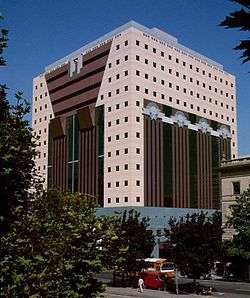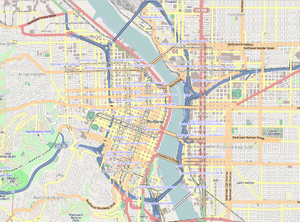Portland Building
| The Portland Building | |
|---|---|
 | |
 Location in Portland | |
| Alternative names | Portland Municipal Services Building |
| General information | |
| Type | Government offices |
| Location |
1120 SW 5th Avenue Portland, Oregon |
| Coordinates | 45°30′56″N 122°40′43″W / 45.515635°N 122.678675°WCoordinates: 45°30′56″N 122°40′43″W / 45.515635°N 122.678675°W |
| Completed | 1982 |
| Opening | October 2, 1982 |
| Cost | US$29 million |
| Owner | City of Portland |
| Height | |
| Roof | 70.41 m (231.0 ft) |
| Technical details | |
| Floor count | 15 |
| Design and construction | |
| Architect |
Michael Graves Emery Roth & Sons |
| Structural engineer | Desimone Consulting Engineers |
| Main contractor |
Hoffman Construction Pavarini Mcgovern Construction |
| References | |
|
Portland Public Service Building | |
| NRHP Reference # | 11000770[4] |
| Added to NRHP | October 25, 2011[5] |
The Portland Building, alternatively referenced as the Portland Municipal Services Building, is a 15-story municipal office building located at 1120 SW 5th Avenue in downtown Portland, Oregon. Built at a cost of US$29 million, it opened in 1982 and was considered architecturally groundbreaking at the time.[6][7] The building houses offices of the City of Portland and is located adjacent to Portland City Hall. It was added to the National Register of Historic Places in 2011.[5]
History
The distinctive look of Michael Graves' Portland Building, with its use of a variety of surface materials and colors, small windows, and inclusion of prominent decorative flourishes, was in stark contrast to the architectural style most commonly used for large office buildings at the time,[7] and made the building an icon of postmodern architecture. It is the first major postmodern building, opening before Philip Johnson's AT&T Building, and its design has been described as a rejection of the Modernist principles established in the early 20th century. Graves' design was selected in a large design competition, with Johnson as one of the three members of the selection committee. Graves was added into the competition after Johnson threw out the entry from architect Gunnar Birkerts for having not been Postmodern enough. Birkerts went on to design the Detroit Institute of Arts South Wing, which was re-clad by Graves in 2007.
Portland mayor Frank Ivancie was among those who expressed the opinion that the modernist style then being applied to most large office buildings had begun to make some American cities' downtowns look "boring",[7] with most of the newer, large buildings being covered in glass and steel, and largely lacking in design features that would make them stand out.[7] Among architects, reaction was mixed, with many criticizing the design while others embraced it as a welcome departure.[7] In 1985, the hammered-copper statue Portlandia was added above the front entrance.[8]
Beyond questions of style, many structural flaws came to light shortly after the building's completion.[9] The building's failings are the subject of much humor and contempt by the civil servants who work there, who describe it as cheaply built and difficult to work in.[10]
In 1990, only eight years after it was built, the lobby and food court were in need of remodeling.[11] Four firms, including Michael Graves, were bidding for the job.[11] Karen Nichols of Michael Graves's firm said "Michael feels like he owes the city one.... We have done a lot of public buildings since then. I do know we talk about the Portland Building all the time."[11]
It suffers from extensive water infiltration and structural issues. In 2014, some city commissioners expressed the view that it should be demolished, one calling it a "white elephant", while at least one commissioner was opposed to that idea.[12] Michael Graves fiercely opposed demolition.[13] In 2015, city officials were considering spending $175 million to fully renovate the building.[14]
In July 2016, plans to renovate the building were moving ahead, with the city council choosing a contractor and setting a maximum cost of $140 million for the work, not including estimated non-construction expenses of up to $55 million, such as for the leasing of office space for around 1,300 city employees who will be temporarily displaced during the renovation work.[15]
Features
The roof of the Portland Building is covered with a green roof, installed in 2006.[16][17] The roof was proposed in 2005,[18] part of an experiment through Oregon State University to test Sedum spathulifolium as a water-absorbing plant for the northwest.[19][20] The new roof will help the building's heating, cooling, and storm-water runoff systems.[21]
Offices
As of October 2009, the Portland Building housed these municipal bureaus and departments: Office of Cable Communications & Franchise Management, Bureau of Environmental Services, Facilities Services, Bureau of Human Resources, Office of Management and Finance, Mt. Hood Cable Regulatory Commission, Bureau of Parks and Recreation, Bureau of Purchases, Bureau of Risk Management, Bureau of Technology Services, Office of Transportation, and the Portland Water Bureau.[22] The Portland Building is located across the street from Portland City Hall.
Reception
In May 1983, the building won an American Institute of Architects honor award.[23]
The building's style remains controversial among Portlanders as well as the entire architecture field.[11] In 1990, The Oregonian stated "it's hard to find anyone who doesn't like Pioneer Courthouse Square.... it's even harder to find anyone who admits to liking the Portland Building."[11] Nearly a quarter century later, Oregonian columnist David Sarasohn revisited the theme, noting that the "huge blue tiles, colored glass and odd pastel flourishes meant to evoke early modern French paintings" actually resembled "something designed by a Third World dictator's mistress' art-student brother."[24]
These laypersons' appraisals were bolstered by Italian-born modernist architect Pietro Belluschi, who called the building "totally wrong" and declared: "It's not architecture, it's packaging. I said at the time that there were only two good things about it: 'It will put Portland on the map, architecturally, and it will never be repeated.'"[11]
Not all commentary has been negative. In the estimation of architectural critic Paul Goldberger: "For better or for worse, the Portland Building overshadows other things. It is more significant for what it did than how well it does it. It had a profound effect on American architecture and brought a return to classicism that brought us better buildings."[11]
In October 2009, Travel + Leisure magazine called the Portland Building "one of the most hated buildings in America".[25]
See also
References
- ↑ Portland Building at Emporis
- ↑ "Portland Building". SkyscraperPage.
- ↑ Portland Building at Structurae
- ↑ "Weekly list of actions taken on properties: 11/07/11 through 11/10/11". National Park Service. November 18, 2011. Retrieved November 23, 2011.
- 1 2 "Portland Building gets a place on national history list". Portland Tribune. November 17, 2011. Retrieved July 6, 2013.
- ↑ "Designs as varied as uses of city's newer buildings". The Oregonian, February 19, 1990.
- 1 2 3 4 5 Weiner, Ed (October 18, 1981). "The most famous building in Seattle is in Portland: Michael Graves' new building is an architectural milestone and is anything but boring". The Seattle Times, p. E1/E4.
- ↑ Crick, Rolla J. (October 7, 1985). "Thousands bid ‘Portlandia’ warm welcome: Statue lifted successfully to final spot". The Oregonian, p. A1.
- ↑ Steffen Silvis (November 10, 1999). "Reaching for the Sky". Willamette Week. Retrieved December 1, 2011.
- ↑ Jeanie Senior (July 15, 2005). "What's not to love about the skyline? A lot, it seems". Portland Tribune. Retrieved October 19, 2010.
- 1 2 3 4 5 6 7 Morris, Rebecca (February 19, 1990). "30 Years of Planning Produce City for '90s". The Oregonian. pp. A01.
- ↑ Brad Schmidt (January 3, 2014). "Portland Building: Four commissioners, four approaches for dealing with Portland's $95 million 'white elephant'". The Oregonian.
- ↑ Rebecca Koffman (October 10, 2014). "The Portland Building: Architect Michael Graves fiercely defends his controversial creation against demolition". The Oregonian.
- ↑ Brad Schmidt (April 29, 2015). "Portland Building overhaul now estimated at $175 million". The Oregonian.
- ↑ Richman, Talia (July 27, 2016). "Contractor, architectural firm picked to renovate Portland Building". The Oregonian. Retrieved August 1, 2016.
- ↑ Genovese, Fran (September 18, 2008). "Some Portland roofs to take on a green hue". The Oregonian. Retrieved October 19, 2010.
- ↑ "Green Roofs". Oregon Field Guide. 2010. Retrieved October 19, 2010.
- ↑ "Twenty years later, Portland Building may get a touch-up". Daily Journal of Commerce. September 21, 2005. Retrieved October 19, 2010.
- ↑ "Greenroof Research in the Pacific Northwest". Oregon State University. Retrieved October 19, 2010.
- ↑ "Extension Service News: OSU scientists open green roof test site to public for tour and discussion (10/01/2007)". Oregon State University. October 1, 2007. Retrieved October 19, 2010.
- ↑ Manfra, Laurie, "Portland Building - 1982 The Michael Graves legacy remains as contentious and confounding as ever.", MetropolisMag.com, April 2006, http://www.metropolismag.com/story/20060320/portland-building-1982
- ↑ "Contact Us: Bureau & Department Listings". City of Portland. Retrieved October 19, 2010.
- ↑ Dickey, Norma H., ed. (1984). Funk & Wagnalls New Encyclopedia: 1984 Year Book. New York: Funk & Wagnalls Publishing Company, Inc. ISBN 0-8343-0069-9.
- ↑ David Sarasohn, "The Portland Building: A Façade Too Weird for Even Portlandia," The Oregonian, Feb. 5, 2014, pg. B4.
- ↑ Bunny Wong (October 2009). "The World's Ugliest Buildings". Travel + Leisure. Retrieved October 18, 2010.
External links
| Wikimedia Commons has media related to The Portland Building. |
- Minor, Kristen. "Portland Building". The Oregon Encyclopedia.
- Portland Building at GreatBuildings.com